|
Harrier T Mk.10/12
& TAV-8B Harrier II
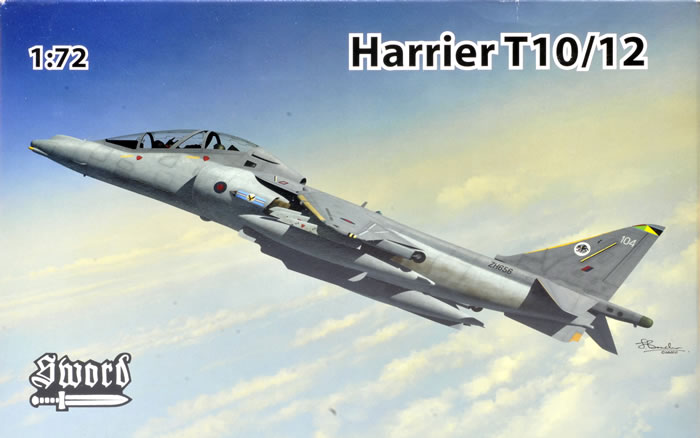
Sword, 1/72 scale
S u m m a r y : |
Catalogue Number: |
Sword Kit Nos.:
SW72099 - Harrier T Mk.10/12
SW72100 – TAV-8B Harrier II |
Scale: |
1/72 |
Contents & Media: |
Kit |
Grey Styrene |
Clear Styrene |
Clear Vac-form |
Resin |
Decal Options |
T.10/12 |
97 |
8 |
1 |
2 |
2 |
TAV-8B |
95 |
7 |
1 |
2 |
3 |
Price: |
Stockist |
T.10/12 |
TAV-8B |
Sword |
€12.96 |
€12.96 |
Hannants |
£12.83 |
£12.83 |
Modelimex |
€15.29 |
€15.29 |
West Coast Hobbys |
Can$23.00 |
Can$23.00 |
Hobby Link Japan |
¥2,160 |
¥2,160 |
Click here for currency conversion... |
Review Type: |
First Look. |
Advantages: |
Finely recessed surface detail is a big improvement on previous kits of the Harrier II trainer variants. The resin Martin Baker Mk.12 ejection seats add a nice detail bonus to the T.10/12 kit. The optional vac-formed canopy will be welcomed by some. |
Disadvantages: |
The closed auxiliary intake doors are disappointing, the LEX shape repeats errors widely reported as affecting other brand Harrier II kits, and the same situation applies to a lack of a deployed air-dam. The ejection sets are the wrong type for the TAV-8B kit. |
Conclusion: |
Sword appears to have derived the master for their kits from the Airfix/Heller kit, but in the process have improved the refinement and presentation of surface detail significantly, as well as providing better cockpit detail and canopies.
Sadly, they have not corrected well known and documented errors associated with the older kit, and so Sword’s kits repeat the misshapen LEX and fail to provide the lowered air-dam required for a model sitting on its undercarriage. This implies a lack of research and limited networking with modellers “in the know, or an attitude that just improving on an old kit by replacing raised with recessed panel detail will be enough to sell (possibly true!).
Sword also missed an opportunity to remedy a failing of many Harrier kits using by providing resin intakes featuring correctly drooped auxiliary intake doors. Instead, they offer miserable and inauthentic depressions resulting from the limitations of injection moulding. Fortunately, Pavla produce resin intakes for the Airfix GR.9 kit that also come with resin exhaust nozzles. These parts should suit the Sword kits equally well.
Sword’s resin ejection seats appear to represent Martin Baker Mk.12s suitable for the T.10/12 boxing, but not the TAV-8B which uses S-III-S (SJU-4) seats. Fortunately, Pavla can provide the correct seat as an aftermarket purchase.
Despite all my griping, Sword has provided us with the most refined Harrier T.10/12 and TAV-8B kits in “The One True Scale”; but they could have given us much more with only a little more effort. As a result I still recommend both kits. |
Reviewed by Mark Davies

Airfix's 1/48 scale Spitfire Mk. Vb will be available online from Squadron.com
Background
The McDonnell Douglas (now Boeing) AV-8B Harrier II is a single-engine ground-attack aircraft that constitutes the second generation of the Harrier Jump Jet family. Capable of vertical or short takeoff and landing (V/STOL), the aircraft was designed in the late 1970s as an Anglo-American development of the British Hawker Siddeley Harrier, the first operational V/STOL aircraft.
Named after a bird of prey, it is primarily employed on light attack or multi-role missions, ranging from close air support of ground troops to armed reconnaissance. The AV-8B is used by the United States Marine Corps (USMC), the Spanish Navy, and the Italian Navy. A variant of the AV-8B, the British Aerospace Harrier II, was developed for the British military, while another, the TAV-8B, is a dedicated two-seat trainer.
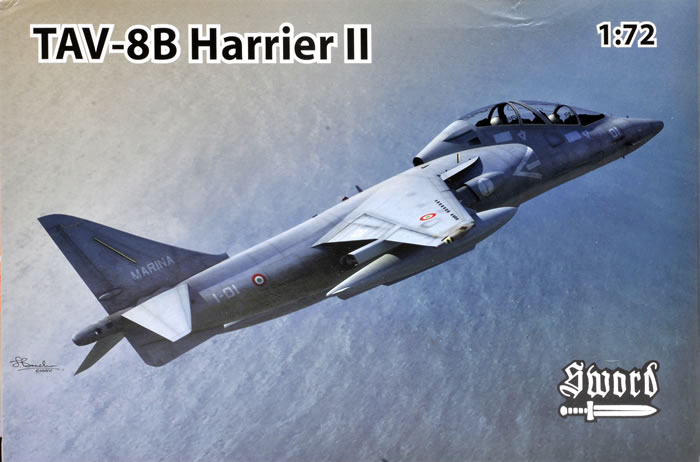
The UK agreement included the involvement of British Aerospace (BAe) as a major subcontractor, manufacturing sections such as the rear fuselage for all customers of the AV-8B. The Harrier II was an Anglicised version of the AV-8B, British Aerospace producing the aircraft as the prime contractor, with McDonnell Douglas serving as a sub-contractor; final assembly work was performed at Dunsfold, England.
The first prototype flew in 1981, first BAe-built development GR5 flew for the first time on 30 April 1985 and the aircraft entered service in July 1987. The GR.5 had many differences from the USMC AV-8B Harriers, such as avionics fit, armaments and equipment; the wing of the GR.5 featured a stainless steel leading edge, giving it different flex characteristics from the AV-8B.
The Harrier T.10 is the British two seat training variant of the Harrier II; based on the USMC Harrier trainer the TAV-8B. Unlike their American counterparts, T.10s are fully combat-capable.
Source: Wikipedia (T.10/12 & TAV-8B)
Previous 1/72 scale Harrier T Mk.2 & T Mk.4 Kits
xI am aware of two previous Harrier 2-seat versions of the Harrier II, one by Italeri and the other is an identical tooling shared by Airfix and Heller. Both trainer kits are a based on their respective brand’s single seat AV-8B/Harrier II toolings. Italeri’s dating from 1982, with the TAV-8B being released in 1989; and the Airfix/Heller TAV-8B/Harrier T.10 dating from 1991 along with its single-seat boxings.
Both kits are typical of their brands and time, with raised surface detail and some shape issues that have been covered in magazine and on-line reviews over the years since their release.
The Contents
Each of the boxings reviewed here share the same contents, with only the decals and colour schemes being different; I shall therefore use the singular kit for most of this “first look” when discussing them both.
Each kit comes in an end-opening box with digital artwork on the front and colour profiles of the decal option on its rear. Sword’s instructions provide a parts map and a generally easy to follow diagrammatic assembly format. All text is exclusively in English and the diagrams are well drawn for a limited-run product.
The painting and decal guide has quite adequate four-view colour drawings, one subject per A5 page, and a single-page stencil placement guide.
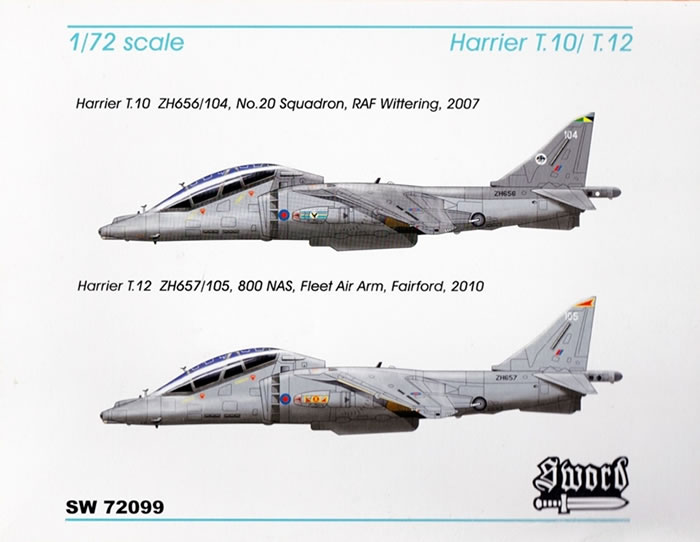
Sword uses includes BS381 and FS-595 codes for colour call outs.
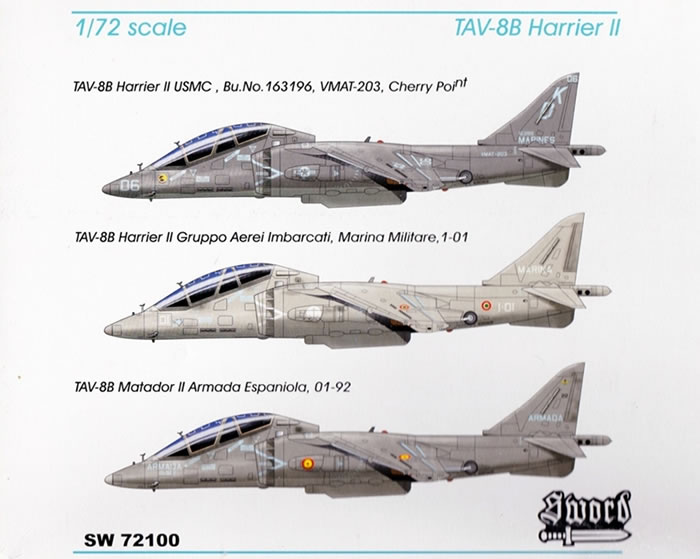
The parts and decals come enclosed in a zip-lock bag, with the clear parts (both injected and vac-formed) further protected in small bags of their own. The two resin ejection seats are loose with the two main sprues, as are the decals.
This is a typical Sword kit in that the plastic has a more shiny finish than many other limited run brands. It has nicely moulded parts with fine surface detail and acceptably fine sprue gates. Residual ejector pin towers require removal in some places to enable a good fit, but none are placed so as to spoil moulded detail, and the mouldings are flash-free. High production standards apply to the resin, and clear parts.
The Kit
Parts breakdown is conventional for the type.
Most of the cockpit detail is just adequate, but fortunately the seats are quite nicely detailed resin components, meaning that some of the most noticeable detail is also the best.
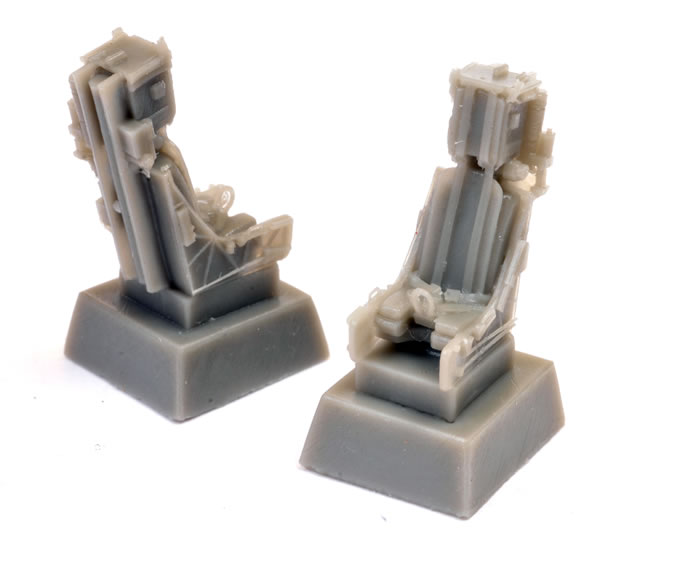
The seats do however present a problem for the TAV-8B option. I am no expert, but I understand that British Harrier IIs use Martin Baker Mk.12 seats, and that AV-8Bs and TAV-8B’s use Stencil S-III-S (SJU-4) seats. I think the kit provides Mk.12 seats suitable for the T.10/12, but not the TAV-8B.
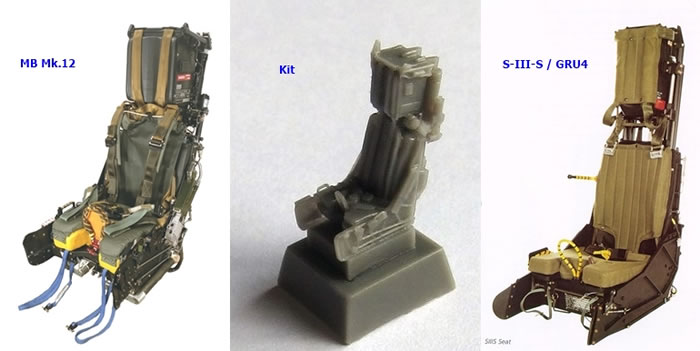
Fortunately, Pavla produces a 1/72 scale S-III-S (GRU-4) seat as an after-market item.
Some may wish to replace the kit’s simple clear-slab HUDs with aftermarket PE items.
So what is supplied is largely fine for a closed canopy model (at least for the T.10/12 option), and may well be enough for some who opt to have open canopies.
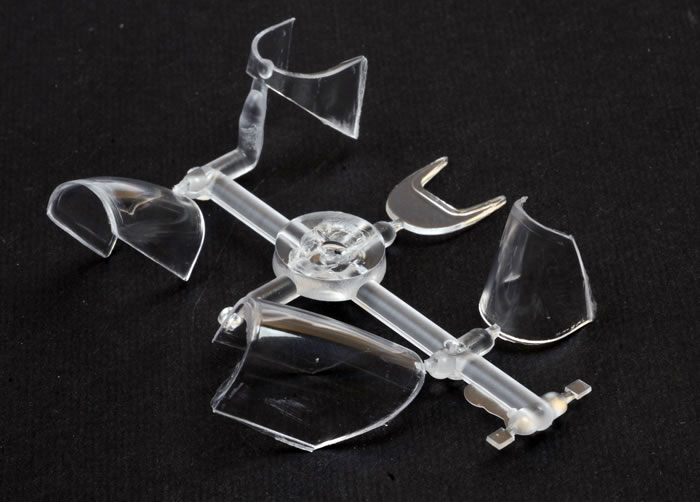
The kit has a multi-piece styrene canopy that can be modelled open, and a vac-formed single-piece canopy offering greater clarity (this of course can also be cut to enable an open canopy display). Decals are provided to represent the canopy det-cord.

The large front fan of the Pegasus engine is very evident and is moulded within its associated intake trunking (just like the Airfix kit). The fuselage halves enclose this, the cockpit, and ventral air-brake housing. Different noses are supplied to cater for the Forward Looking Infra Red (FLIR) example fitted to the T.10/12 and the simple cone fitted to the TAV-8B.
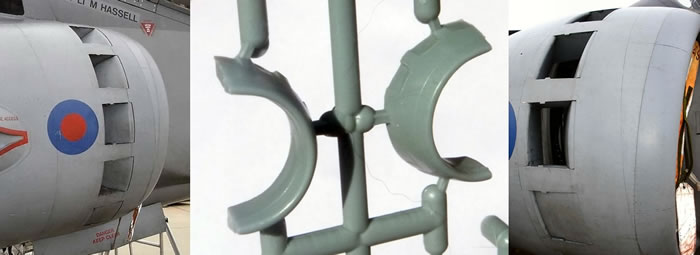
Now to a real weakness of this kit, and it is one that many Harrier kits share. The uppermost and side auxiliary intake doors are moulded as slight depressions, rather than drooped fully open as they are when the engine is shut down. This is due to the limitations of Sword’s simple two-piece injection moulds, but could have been avoided if resin intakes had been used here I feel.
Fortunately, Pavla produce resin intakes for the Airfix GR.9 kit that also come with resin exhaust nozzles. These parts should suit the Sword kits equally well.
Some may gripe about the lack of vanes within the “cold” forward engine nozzles, and the awkward seams down the middle of the dived “hot” rear; but both issues can be overcome easily enough or use the Pavla nozzles mentioned above.
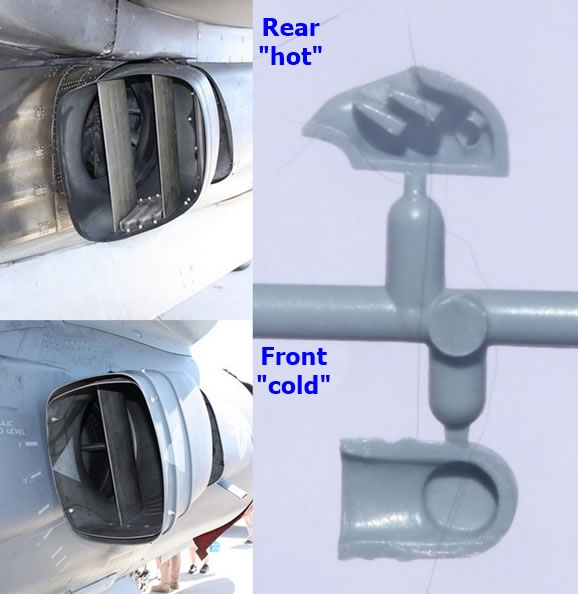
Less easy to fix is the apparent error in the shape of the Leading Edge Extensions (LEX) and the angle at which they blend into the upper fuselage just behind the rear cockpit. The kit’s LEXs are too angled inwards towards the front where they join the fuselage, whereas they should be more parallel with fuselage centreline. The LEX leading edge seems to also be slightly off in outline, and would benefit from thinning down.
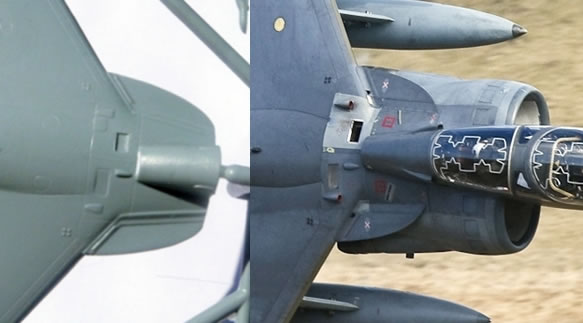
Another concern with the kit is its closed lift augmentation cross-dam, which I shall refer to as an air-dam. When landing and/or on the ground the Harrier II’s air-dam, a panel just behind the nose-wheel, extends to perpendicular with the fuselage underside and closes the space between the under-fuselage Lift Improvement Devices (LIDs), or in layman terms, the strakes in place of cannon fairings (the air dam is also lowered when the cannon or just their fairings are fitted, as these serve as LIDS).
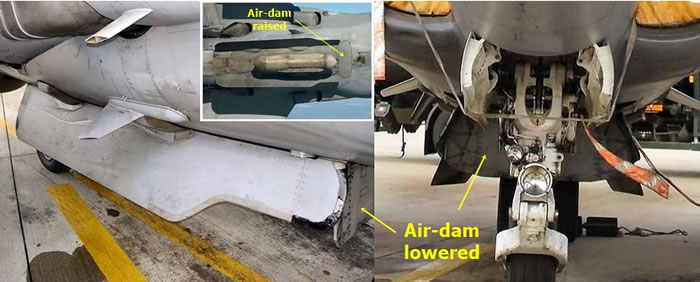
The kit includes the engraved outline of the air-dam, but it will take a bit of effort to replicate a lowered dam and its housing that is really required by a model on its undercarriage (the kit does not provide an in-flight undercarriage option).
In many respects, the kit resembles the Airfix/Heller offering in shape and parts breakdown. This is also a view supported by comments on some leading modelling forums. I cannot be sure, but Sword may well be using metal-spray or galvanised, epoxy toolings, in which case their master may well be based on the Airfix/Heller kit. Whatever its origins, Sword cannot be excused for repeating the LEX and air dam errors as these points have been raised in reviews and forum discussions for over 25 years since the Airfix/Heller kit’s.
Another aspect that seems similar to the Airfix/Heller kit, and pertaining to the T.10/12, is the shape of the nose. This incorporates the clear glazing for the Angle Rate Bombing System (ARBS) laser in the tip of the nose, and immediately beneath are the two Zeus ECM sensors. Having looked at the Sword kit parts and finished examples of the Airfix/Heller kit, I feel that they may look a little too narrow and pointy. I mention it as a point for readers to judge for themselves by comparing their kit parts to reference images.

Pavla produces replacement Zeus ICM fairings for the Airfix GR.9 kit, but they seem an easy item to scratch-build if you are not happy with the kit items.
The tandem undercarriage units have a quite adequate appearance, as do the main wheels and their doors. Sword has moulded the outriggers in their lowered state, which should suit the majority of modellers (but really requires a lowered air-dam to be scratch-built as mentioned above).
The wings consist of three parts. The vortex generators are a little thick, but are limited by what is possible with injection moulding. They are better than some other Harrier kits in this respect, and they should be acceptable to most I feel.
The T.10/12 has four underwing pylons and two fuel tanks provide the only aircraft stores, although more stores would have been nice. The TAV-8B only requires the two fuel tanks and their pylons, as this version does not carry offensive stores. As a result, the TAV-8B has separate control surface actuator bugles, whereas the T.10/12 has them incorporated into the store pylons. This said; the most out-board bulge for the TAV-8B needs to be cut off from the applicable pylon intended for the T.10/12.
From what I have observed, the T.10/12 carries the fuel tanks on the stores pylon inboard of the undercarriage outriggers, whilst the TAV-8B’s only pylons are fitted immediately outboard of these. I have also read that British Harrier II pylons differ from those fitted to single-seat AV-8B’s as they are required to carry heavier loads, plus they have an additional dedicated Sidewinder missile pylon in the outboard position. Since Sword has provided four rather than three underwing pylons for the T.10/12 kit I assume that they are the correct British style.
I think this should be a simple and enjoyable kit to build, albeit that there are some fiddly annoying fixes to contend with if the LEX shape and lack of lowered air-dam bother you; and if they do, it will surely mean you want to improved the auxiliary inlet doors too.
Markings
The T.10/12 boxing has two decal options:
-
T.10, ZH656 / 104, No 20 Squadron RAF, RAF Wittering, 2007; and
-
T.12, ZH657 / 105, 800 NAS, Fleet Air Arm, Fairford 2010;
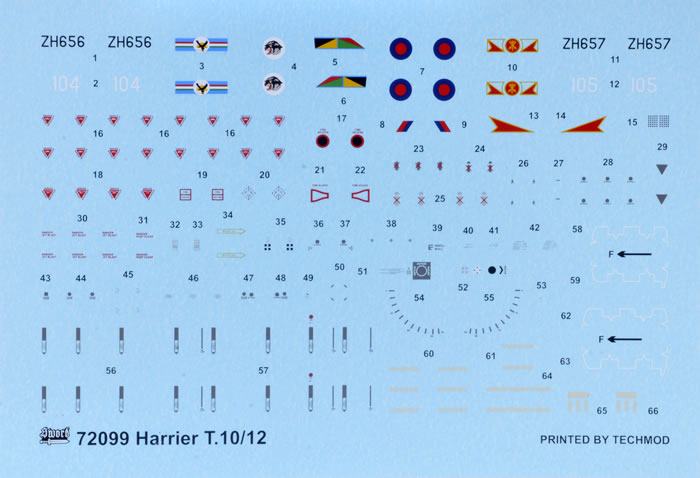
And the TAV-8B boxing has three:
-
Bu No 163196, VMAT-2013,USMC, Cherry Point;
-
1-01, Gruppo Aerei Imbarcati, Marina Militaire; and
-
01-92, Armada Espaniola.
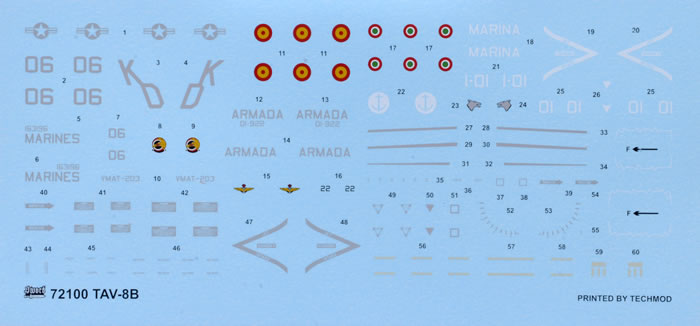
The decals are printed by Techmod and appear to excellent in all respects. They include a large number of stencil markings.
Sword appears to have derived the master for their kits from the Airfix/Heller kit, but in the process have improved the refinement and presentation of surface detail significantly, as well as providing better cockpit detail and canopies.
Sadly, they have not corrected well known and documented errors associated with the older kit, and so Sword’s kits repeat the misshapen LEX and fail to provide the lowered air-dam required for a model sitting on its undercarriage. This implies a lack of research and limited networking with modellers “in the know”, or an attitude that just improving on an old kit by replacing raised with recessed panel detail will be enough to sell (possibly true!).
Sword also missed an opportunity to remedy a failing of many Harrier kits using by providing resin intakes featuring correctly drooped auxiliary intake doors. Instead, they offer miserable and inauthentic depressions resulting from the limitations of injection moulding. Fortunately, Pavla produce resin intakes for the Airfix GR.9 kit that also come with resin exhaust nozzles. These parts should suit the Sword kits equally well.
Sword’s resin ejection seats appear to represent Martin Baker Mk.12s suitable for the T.10/12 boxing, but not the TAV-8B which uses S-III-S (SJU-4) seats. Fortunately, Pavla can provide the correct seat as an aftermarket purchase.
Despite all my griping, Sword has provided us with the most refined Harrier T.10/12 and TAV-8B kits in “The One True Scale”; but they could have given us much more with only a little more effort. As a result I still recommend both kits.
Thanks to Sword Models for the review samples.
Text and Images Copyright © 2017 by Mark Davies
Page Created 12 April, 2017
Last updated
12 April, 2017
Back to HyperScale Main Page |
